
Director
Chu Talks About New Contract and New Beginning
A Step Closer to Technology
of the Future
Director Chu Talks About New Contract and New Beginning
“The good news is we have a new contract!” Berkeley Lab
Director Steve Chu exclaimed to open his first all-hands “State
of the Lab” talk on May 16 at noon in the Building 50 auditorium.
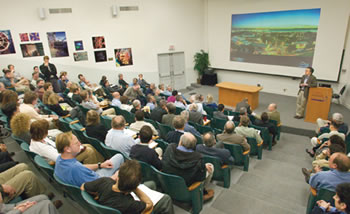 A Lab employee asks Director Chu a question during the all-hands talk
in the Building 50 auditorium last week. photo by Roy Kaltschmidt,
CSO
A Lab employee asks Director Chu a question during the all-hands talk
in the Building 50 auditorium last week. photo by Roy Kaltschmidt,
CSO
During his hour-long talk, which was streamed live on the web, the Director covered a broad range of topics. In addition to discussing the new contract, he praised the legacy of Lab founder Ernest Lawrence, expressed confidence that the new energy secretary, Samuel Bodman, will be an advocate for science, and made a strong case for revitalizing the Lab’s infrastructure. First, however, he shared some thoughts on DOE’s announcement that it has awarded a new five-year contract to the University of California to manage and operate Berkeley Lab. This was the first DOE science lab to go through this process.
“You might have thought that DOE renewing the UC management contract was a slam dunk, but we took this competition very seriously,” Chu said. “The Lab went for 74 years without a competition and then we became the guinea pig, the test case.”
In discussing the proposed Office of Science budget, Chu noted that it was put together during a transition time in the Department of Energy. Now that Bodman, a former MIT chemical engineering professor turned corporate financier who also served in the first Bush administration, has taken office, Chu believes that DOE science has a new and assertive voice speaking on its behalf.
“Samuel Bodman didn’t need this job to pad his résumé,” Chu said. “He has a strong history of getting things done.”
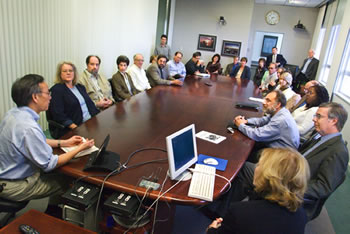 Director Chu hosted a private ceremony the day after the all-hands
meeting to hand out Outstanding Performance Awards to 24 employees
who went beyond the call of duty to work on the management contract
and make its success possible. They are, in alphabetical order, Chuck
Axthelm, David Bailey, Alex Ballard (LLNL), Jane Baynes, David Busby,
Michael Chartock, Cynthia Coolahan, Carla Garbis, Rob Johnson, Denise
Kellom (LLNL), Jim Krupnick, Karin Levy, Linda Matyas, Michele Mock,
Pam Patterson, Paul Preuss, Joseph Rasson, Art Robinson, Jennifer
Rosado, Mark Rosenberg, Ed Sayson, Cheryl Ventimiglia, Jeff Weiner,
and Otis Wong.
Director Chu hosted a private ceremony the day after the all-hands
meeting to hand out Outstanding Performance Awards to 24 employees
who went beyond the call of duty to work on the management contract
and make its success possible. They are, in alphabetical order, Chuck
Axthelm, David Bailey, Alex Ballard (LLNL), Jane Baynes, David Busby,
Michael Chartock, Cynthia Coolahan, Carla Garbis, Rob Johnson, Denise
Kellom (LLNL), Jim Krupnick, Karin Levy, Linda Matyas, Michele Mock,
Pam Patterson, Paul Preuss, Joseph Rasson, Art Robinson, Jennifer
Rosado, Mark Rosenberg, Ed Sayson, Cheryl Ventimiglia, Jeff Weiner,
and Otis Wong.
Speaking of getting things done, Chu cited a quote from Berkeley Lab’s founder about there being “enough research for all of us to do” as a motto for the Lab’s traditional role in multidisciplinary scientific efforts, both here and in collaboration with researchers at other institutes, and its legacy of training future generations of scientists and engineers.
“This spirit of generosity and cooperation is a tradition that I am very proud to be a part of and plan to continue,” Chu said.
He also spoke at length about the need to renew and revitalize the Laboratory’s aging infrastructure, and his hopes for doing so through partnerships with UC Berkeley.
“Old Town was old when I was a graduate student in the 1970s,” Chu said. “Sixty percent of our buildings are more than 40 years old, and about 25 percent are more than 50 years old. If we don’t do something about our infrastructure, we won’t be able to do the things we want to do, or recruit the people we need to recruit.”
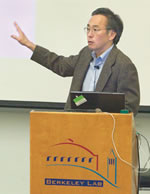
Chu has proposed a partnership with UC Berkeley to build three new dual-use facilities: a $90 million computational research and theory building, a $91 million nanophysics research laboratory, and a $7.5 million Berkeley Lab guest house. While the Laboratory would help service the debt by finding ways to cut back on its overhead spending, Chu emphasized several times that he is not proposing to “trade people for buildings.”
Acknowledging that the task to find funding for new facilities is formidable, Chu said, “Nothing will happen overnight. This process will take a period of months or even years, but we need to address the issue now because our buildings are just going to get older and older. In order to make the process work, however, we need buy-in from the Lab community.”
As part of his outreach effort to the Lab community, Chu plans to set up a “director’s table” in the cafeteria twice a month, from noon to 1:30 p.m. During that time, employees from a specific division or group, designated on a rotational basis, will have the opportunity to meet with him and share their views and concerns.
A Step Closer to Technology of the Future
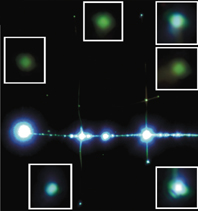
This dark-field image shows optical routing in a rectangular nanoribbon
grid. The photoluminescence results as the input channel is pumped
with laser light pulses.
With those slow computers and that sludgelike Internet, how did they ever get anything done? That’s what people of the future will wonder if the promise of photonic technology is ever realized. Unlike electronic technology, which is based on the manipulation of electrons, photonic technology would be based on the manipulation of light waves (photons). It’s been estimated that a photonic Internet could transmit data at 160 gigabits per second, thousands of times faster than today’s typical high-speed connection. Optical computers could solve problems in seconds that would take today’s electronic computers months or even years to solve.
Photonic technology, at least on a nanoscale, is now a few steps closer to becoming science fact. Scientists with Berkeley Lab and UC Berkeley, working with free-standing, chemically synthesized nanowires and nanoribbons, have been able to guide pulses of laser light through a variety of complex structures. They have even been able to transmit those pulses within a liquid for the first time.
“We’ve been able to assemble nanowire lasers and semiconductor nanoribbon waveguides into multi-wire model structures that illustrate how light can be transmitted between active and passive nanoscale diameter cavities,” said Peidong Yang, a chemist with the Materials Sciences Division and a professor with UC Berkeley’s Chemistry Department, who led this research. “We’ve also introduced a major new application area for nanoribbons and nanowires as nanoscale optical waveguides in a liquid media, which holds importance for microfluidics and biology.”
Yang and his research group are at the forefront in the development of semiconductor nanowires and nanoribbons, single crystals that can measure a millimeter in length, but only a few hundred nanometers or less in width and thickness (about one ten-millionth of an inch). They’ve demonstrated that these nano-sized ribbons can serve as “waveguides” for channeling and directing the movement of light waves through circuitry. Integrated circuitry on a nanoscale (a thousand times smaller than today’s microcircuits) is a critical requirement for photonic technology.
“Over the past couple of years, we’ve worked heavily towards using nanowires as building blocks for the purpose of photonic applications,” Yang said. “So far, we’ve made nanoscale lasers, photodetectors, and ribbons that serve as flexible subwavelength optical waveguides. Ultimately, we want to integrate all these individual components together into a photonic system-on-a-chip that could be used to perform instant and detailed analyses for studies in chemistry, biology and medicine.”
In the May 20 edition of the Proceedings of the National Academy of Sciences (PNAS), Yang and several collaborators report on the coupling of nanowire lasers, made from either gallium nitride or zinc oxide, to nanoribbons, made from tin oxide, a semiconductor of keen technological interest for its exceptional potential to be used to transport both photons and electrons in nanoscale components. The nanowire lasers, which were developed by Yang’s research group, are pure nanosized crystals that emit coherent ultraviolet light via a process called “optical pumping.”
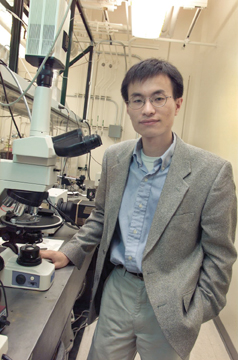 Peidong Yang was named the 2004 Materials Research Society Outstanding
Young Investigator for his nanoscale photonic research.
Peidong Yang was named the 2004 Materials Research Society Outstanding
Young Investigator for his nanoscale photonic research.
Yang and his co-authors show that it is possible to transport individual pulses of laser light from the nanowires to the ribbon waveguides, a prerequisite if photonic devices are to be useful in communications or computing applications. They also demonstrate that networks of the tin oxide nanoribbons can be used as multi-channel filters for separating the component colors of white light and routing them through individual channels.
Perhaps the most intriguing of the results reported in the PNAS paper was the demonstration by the authors that their high refractive-index nanowires and nanoribbons can be used to guide light in water and other liquids. In one test, the tip of a nanoribbon was embedded with a droplet of laser dye, and a nanopulse of blue light was then sent into the far end of the ribbon. This produced a strong fluorescence from within the droplet, a fraction of which was captured by the ribbon cavity and guided back to the ribbon’s far end, proving that these waveguides are capable of routing signals both to and from liquids.
“The fact that the wave guiding ability of our freestanding, flexible wires and ribbons survives in liquid media suggests a role for nanowire light delivery in integrated on-chip chemical analysis and biological spectroscopy,” said Yang.
The timeframe for when nano-scale photonic technology will be ready for primetime consumption is difficult to predict, as a number of issues must first be resolved, including the need for a way to chemically synthesize geometrically precise nanowires and nanoribbons in mass quantities. Yang and his group are exploring several promising techniques for accomplishing this, including the use of optical traps.
“I think we could soon be seeing commercial application of nanowires and nanoribbons in areas that require less integration, such as sensing and energy conversion,” Yang said. “However, for applications that require a high level of integration, it will take much longer.”
Co-authoring the PNAS paper with Yang were Donald Sirbuly, Matt Law, Peter Pauzauskie, Haoquan Yan, Alex Maslov, Kelly Knutsen, Cun-Zheng Ning and Richard Saykally. Maslov and Ning are with the NASA Ames Research Center; the others are with Berkeley Lab, UC Berkeley or both.
A Toast to the New Contract
Anyone could tell it was a happy occasion. With champagne glasses in one hand, food in the other, and smiles across their faces, employees gathered in the cafeteria dining room last Tuesday to celebrate, alongside Director Steve Chu, the awarding of the contract that allows the University of California to continue managing Berkeley Lab.
Chu and others gave brief remarks during the event, held on May 17 in the cafeteria, lauding everyone’s assistance in winning the bid, particularly the individuals who worked on the Contract Acquisition Team.
“There were some trying times during this competition, and it occasionally looked bleak, but everyone pulled together and gave it their all to make it happen,” Chu said, and then added, “The camaraderie here is outstanding, something I haven’t felt at the other organizations I’ve worked for. And it’s a spirit I’ve seen not just in the contract bid, but in our day-to-day business as well. You all have so much to be proud of.”
“A lot people in the press portrayed this bid as a slam dunk for us,” said Lab Deputy Director Graham Fleming. “But that’s not what everyone involved felt. We knew we were competing against ourselves.”
“What I find amazing is this had never been done before, it was unplowed territory,” said Associate Lab Director David McGraw of the contract bid. “But it was done remarkably well.” — Lyn Hunter
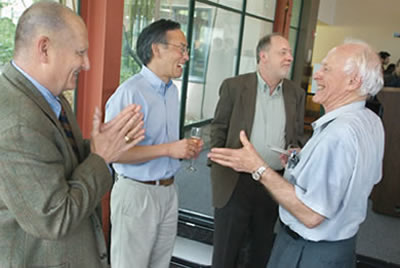
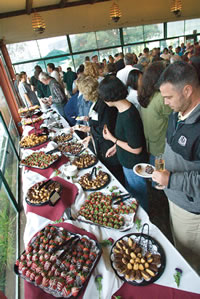
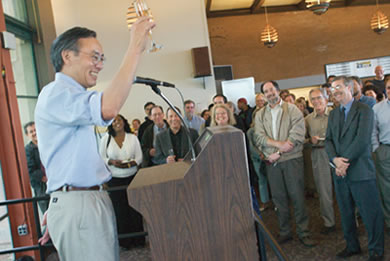
(Top): David McGraw, Director Chu and Graham Fleming chat with members of
the Lab community during the May 17 contract celebration.
New Berkeley Lab Events Calendar Goes Online
Looking for a science lecture? Yoga class? Now you can find it with a click of your mouse. For the first time, Lab employees now have access to a comprehensive and searchable online listing of all activities taking place at Berkeley Lab. Moreover, in addition to viewing and searching for events, you can now submit your own.
The calendar website lists events taking place on the current date and allows users to either look up future dates or search the calendar using a variety of criteria, such as date or date range, event sponsor, type of event, scientific discipline, or keyword.
To submit events sponsored by their group, users need to log in using their LDAP user name and password. If you add more than one event at a time, a new form pops up which retains the information of the previous event, so users can save time by retyping only the fields that need to be changed. Once an event is successfully submitted, users receive a confirmation e-mail. After submission you may change or delete an event using the “modify event” function.
Events submitted to the online calendar will be used in the calendar section of Today at Berkeley Lab, as long as they meet the TABL deadline. The calendar will be updated every 24 hours and events will be posted at the editor’s discretion.
The calendar was created jointly by Public Affairs Communications Office and the Information Technology Division’s Information Systems and Services group. It can be accessed directly from the Lab’s home page and from the calendar section of Today at Berkeley Lab.
What Will It Take to Extend Contract to 20 Years?
An intriguing clause in the new University of California contract with the Department of Energy to manage Berkeley Lab has an incentive to allow UC and the Lab to skip the contract competition every five years, for up to 20 years.
While that prospect is certainly desirable, achieving it won’t be easy. It all boils down to Lab performance in various appraisal areas. Anything less than an “outstanding” rating overall could trigger a new competition for the contract.
The scoring methodology and measures have changed since the last contract and will now reflect commonality across all of the Office of Science laboratories. A numerical four-point rating system and a “report card” approach will replace adjectival scores (good, excellent, outstanding, etc.). And the operational performance — formerly just a percentage of the total score — now becomes a key determinant in how much fee is actually awarded to UC and the Lab.
Although the specifics of the measures are still begin tweaked by the DOE, eight areas are being graded on the report card:
1. Mission accomplishment (quality and productivity of R&D)
2. Construction and operation of research facilities
3. Science and technology (S&T) project/program management
4. Contract leadership/stewardship
5. Environmental safety and health
6. Business systems
7. Facilities maintenance and infrastructure
8. Security and emergency management
A low grade in any one of those categories can affect the overall score in a way that could deny an extension of the contract, according to Associate Laboratory Director for Operations David McGraw.
“For example,” he said, “in Environment, Safety and Health, we will be graded on how well we do preventing worker injury and illness and in our integrated safety management. That’s one of the reasons why it is so important for every member of the Laboratory to work safely and to maintain a safe work environment. UC management will not be extended unless we do.”
Some of the specific evaluative measures within some of the categories listed above include:
- Lab management (strategic vision and planning, employee morale, corporate partnerships, public outreach and education, technology transfer)
- Business systems (financial and human resources management, diversity, property management, network and information systems reliability, indirect cost containment)
- Facilities and infrastructure (property, construction, maintenance and energy management)
- Science and technology (planning and development of initiatives, recruitment of key positions, stewardship and growth of existing capability, use and management of Laboratory Directed Research and Development (LDRD) funds
Beginning in Fiscal Year 2006, two scores will determine the fee and the possible contract extension. The first, the S&T score, sets the maximum winnable fee within the total amount of fees available. The operational score then determines how much fee is actually awarded.
In the proposed scoring system, an A+ could be earned with an overall 4.3 numerical score or better. An A is given at 4.0, an A- at 3.7, a B+ at 3.4 and the B at 3.0. As in graduate school, anything less than a B is really not acceptable performance. Expectations will be set in five operational and three S&T performance areas. A Lab achieving “outstanding” ratings (above 3.5) in all categories will gain an additional year of the contract for the same management system.
Lab Organization Reflects Interdisciplinary Approach
The management organization chart announced recently by Berkeley Lab Director Steve Chu is assembled divisionally along four disciplinary lines of research, with an emphasis on connections between departments that foster untraditional interactions and team solutions to problems. The chart also reflects the importance placed upon fiscal responsibility in the new management contract with the University of California.
Five associate laboratory directors (ALDs) and the chief financial officer are given primary responsibility for managing the Laboratory’s business in science and support services under Chu and his deputy director Graham Fleming.
In the new configuration, the Engineering Division is placed in the General Sciences directorate under ALD Jim Siegrist, because of its preponderance of projects with the Accelerator and Fusion Research, Nuclear Science, and Physics divisions.
The Physical Sciences, under ALD Paul Alivisatos, includes his own Materials Sciences Division along with four other divisions that are expected to collaborate on several new initiatives, including development of a carbon-neutral energy source: Chemical Sciences, Environ-mental Energy Technologies, Physical Biosciences, and the Advanced Light Source. Alivisatos last week announced his resignation as director of the Molecular Foundry so that he could devote most of his time to the physical sciences directorate.
In a similar way, the Earth Sciences Division has been placed within the Life and Environmental Sciences directorate under ALD Joe Gray, due to the programmatic sharing — such as genome sequencing — that will benefit all three divisions (Earth Sciences, Genomics, and Life Sciences). For example, microbes that might prove beneficial in a multitude of ways are being studied in Life Sciences, Genomics and Earth Sciences.
ALD Horst Simon continues to manage the Computing Sciences directorate, while ALD David McGraw manages Operations, including Environ-ment, Health and Safety, Facilities, Human Resources, Public Affairs and Workforce Diversity. Jeffrey Fernandez oversees the budget as chief financial officer.
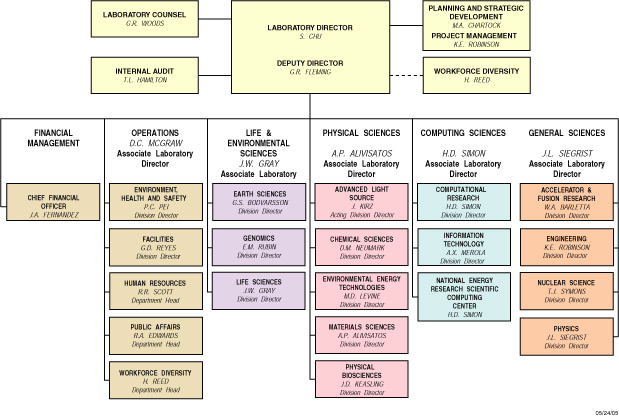
Science, Salutes: Shank Has His Day
Chuck Shank returned on Tuesday to the place where he held court for 15 years, but this time he was on the receiving end. And receive he did. Amid the glittering array of scientific talks in an all-day symposium in the Building 50 auditorium, Berkeley Lab’s previous director was showered with accolades for both his research achievements and his contributions as leader of the Lab.
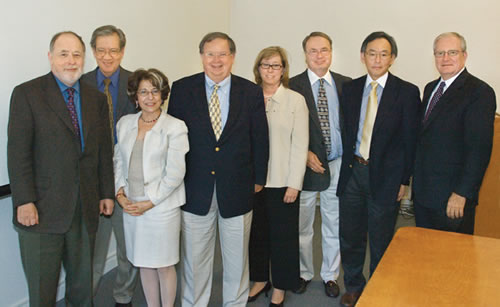
Former Lab Director Charles Shank is flanked by friends and former colleagues during the symposium in his honor. Left to right are Graham Fleming, MIchael Chartock, Mina Bissell, Charles Shank, Sally Benson, Charles Harris, Director Steve Chu, and Presidential Science Advisor John Marburger. Photo by Roy Kaltschmidt, CSO
“Having worked with and for Chuck, I’ve come to one conclusion,” said his successor and former Bell Laboratories colleague Steve Chu. “There’s only one place [for me] to go, and that’s downhill. But I’ll do all I can do to keep the Lab a truly outstanding place, as Chuck has left it.”
Chu kicked off a series of stimulating summaries of 21st century research, most of it nurtured by Shank during his tenure here. The cast included Presidential Science Advisor John Marburger, Univer-sity of California Regent Peter Preuss, UC Berkeley Chancellor Bob Birgeneau, and Vice President of the Howard Hughes Medical Institute Gerry Rubin. Berkeley Lab scientists Phil Collela, Saul Perlmutter, Jill Banfield, and Eva Nogales, plus visiting distinguished researchers Erich Ippen of MIT and Nate Lewis of Caltech, each gave half-hour synopses of their work. Distinguished Scientist Mina Bissell and Deputy Director Graham Fleming hosted the symposium.
Marburger, who summarized his interest in advancing the field of ultra-fast science that was pioneered by Shank when he was at Bell Labs, said, “I hope that Chuck will not completely withdraw his interest in the field. Short optical-pulse generation (is poised to) make great progress over the next five years. I fully expect Chuck to be engaged.” And he said to Shank, “Thanks for the contributions you made to science and to the profession of making science valuable at the national laboratories.”
Birgeneau recalled the time, following his own committee’s critical review of the Advanced Light Source, that Shank — instead of “killing the messenger” — “picked up the phone, asked me to come out here, and to help get [the ALS] going in the right direction. I knew at that point that the ALS would be ok, and I’m not surprised that it has now evolved into a lead national facility.” He added, “What an incredible director Chuck was.”
Similar accolades followed: for his role in bringing the National Energy Research Scientific Comp-uting Center to the Lab, for his visionary development of Lab programs responsive to national needs, for getting the Laboratory to focus more on biology, and for building productive partnerships with the Department of Energy.
Fleming presented Shank with a brass plaque that will hang in the lobby of the new nanoscience building, now under construction, inscribed with the ex-director’s image and the words, “Under Director Shank’s Leadership the Molecular Foundry Became Reality.”
Suddenly reduced to a man of few words, Chuck Shank said simply, at the end of the day, “Thank you for the privilege of working with you. Thank you all so very much. It is most appreciated.”
Budget Update
Good News for Lab in House Appropriations Bill
The U.S. House of Represen-tatives has passed its version of the FY 2006 Energy and Water Develop-ment Appropriations bill by a vote of 416 to 13, with all Bay Area legislators voting for the bill. H.R. 2419 would fund the Department of Energy at $24.6 billion, $361.5 million above the Administration’s budget request. Thus the picture looks a bit better for science.
The Senate’s Appropriations Subcommittee on Energy and Water Development is expected to consider its version of the legislation after returning from Memorial Day Recess on June 6.
Specifically, the House bill would fund the Office of Science at $3.7 billion, $66 million more than FY05 and $203 million above the Presi-dent’s request. As explained in the legislative report accompanying the bill, the Appropriations Committee’s priorities for the Office of Science are high-performance computing, operating time at user facilities, and redirection of fusion research to restore the domestic program.
The Office of Advanced Scien-tific Computing received $39 million over the President’s request. This account funds Berkeley Lab programs like the NERSC supercomputing center and the Energy Sciences Network (ESNet).
Other good news for Berkeley Lab includes increased funding for the Science Laboratories Infrastructure account, at $42.1 million. The President’s request includes $11 million to begin demolition of the Bevatron. Fusion Energy Research’s budget includes money for heavy ion and fast ignition fusion.
The Basic Energy Sciences budget would increase by $70 million over the Administration’s request, to $525.7 million. Particularly important for Berkeley Lab, $35 million would be set aside for medical applications. The President’s budget had virtually zeroed this program out.
The legislative report does include tough language on Lab Directed Research and Development (LDRD), which would limit LDRD to no more than $250 million per year department-wide — compared to roughly $400 million in FY04. An amendment was offered by Rep. Judy Biggert (R-IL), chair of the Science Subcommittee on Energy, to strike these LDRD provisions. However, Biggert withdrew her amendment after Energy and Water Chairman David Hobson (R-OH) committed to working with her to “refine” the provisions before conference with the Senate.
JGI Announces 2006 Community Sequencing Program Portfolio

The study of Petrolisthes cinctipes, the porcelain crab, may provide
information for climate change research because of the crab's unusal
heat and cold tolerance.
Forty new genome projects, representing a cornucopia of life forms — from grain to catfish, crustaceans, and a host of extreme-lifestyle microbes — are slated for DNA sequencing at the Joint Genome Institute (JGI) through the Commun-ity Sequencing Program. The information to be gleaned from the program will provide important lessons for interpreting the complex systems that regulate the health of our planet, and will benefit research in agriculture, climate change, waste cleanup, and alternative energy.
“Through the Community Sequencing Program we are leveraging the dramatic advances in genomic technology accrued since DOE launched the Human Genome Project nearly 20 years ago,” said Raymond Orbach, director of the DOE Office of Science. “These advances have enabled DOE JGI to emerge as one of the preeminent contributors to microbial and plant genomics.”
JGI, already among the most productive genome sequencing centers in the world with more than 225 organisms to its credit, is poised to add significantly to this total and to the scientific literature through its Community Sequencing Program (CSP). With the 2006 CSP allocation, JGI will be making freely available to the scientific com-munity 20 billion letters of genetic code (bases) — roughly the equivalent of nearly seven human genomes of information.
 The tropical grain Sorghum bicolor, the largest single genome selected
this year, is expected to provide information for the study of other
agriculturally-important and genetically-related grains, such as maize,
millet and sugarcane.
The tropical grain Sorghum bicolor, the largest single genome selected
this year, is expected to provide information for the study of other
agriculturally-important and genetically-related grains, such as maize,
millet and sugarcane.
The largest single genome selected this year is the tropical grain Sorghum bicolor, with an economic importance worldwide exceeding $69 billion per year. This grain’s sequencing is expected to provide an improved blueprint for the study of other important grains such as maize, millet and sugarcane, and serve as a valuable reference for analyzing the four-fold larger genome of maize, the leading U.S. fuel ethanol crop. Sorghum is an even closer relative of sugarcane, arguably the most important biofuels crop worldwide.
Another CSP large genome target is Mimulus guttatus, the common or “seep spring” monkey flower. “By sequencing the monkey flower, DOE JGI will be enabling genomicists to pioneer new territory, taking on one of the most difficult and fundamental questions in evolutionary biology — how new species evolve,” said Richard A. Jorgensen, associate professor of plant sciences at the University of Arizona.
One of DOE’s most enduring goals is to replace fossil fuels with renewable sources of cleaner energy, such as hydrogen produced from plant biomass fermentation. The lowly termite is actually one of the planet’s most efficient bioreactors, capable of cranking out two liters of hydrogen from fermenting just one sheet of paper. JGI will be sequencing this community of microbes to provide a better understanding of the biochemical pathways used by the termite’s gut. This knowledge may lead to more efficient strategies for converting biomass to fuels and chemicals and may one day make biological production of this alternative energy source a viable option.
JGI will also be casting deep into the aquatic gene pool — sequencing genes from two species of catfish and five species of fish from Lake Malawi in east Africa. The 40 CSP projects will also include a metagenomic community of waste-degrading bacteria capable of treating contaminated industrial streams, and Petrolisthes cinctipes, the porcelain crab, whose heat and cold tolerance will help inform climate change research.
The full roster of CSP organisms can be found at http://www.jgi.doe.gov/sequencing/cspseqplans2006.html.
Lab’s Soil and Groundwater Cleanup Forges Ahead
Berkeley Lab is nearing the final phase of a 15-year U.S. Department of Energy-mandated effort to address the Lab’s soil and groundwater contamination.
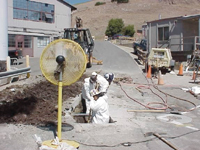
A new extraction well is being drilled for a soil flushing pilot test
at Building 52.
Since the project started in 1991, more than 170 areas around Berkeley Lab have been investigated as suspected contaminated sites from historical or no longer operating research. Of these, all but 13 areas have been either cleaned up or proved to have no significant contamination. Work is underway to address these remaining sites.
“Importantly, all contaminated material is safely confined within Berkeley Lab’s property,” says Iraj Javandel, program manager of Berkeley Lab’s Environmental Restoration Program and a senior scientist in the Earth Sciences Division. “No groundwater contamination has migrated off the Lab’s site and no tritium has been detected in offsite creeks during the last two-and-a-half years. There is no health risk to the public at large.”
The final phase in the cleanup effort involves the implementation of corrective measures designed to remediate the remaining 13 contaminated areas. The DOE has established September 2006 as Berkeley Lab’s deadline for this phase, which is just 17 months from now.
“This doesn’t mean that everything has to be cleaned up by next year,” says Javandel. “It means that whatever instrumentation needs to be in place is in place, and that operations and maintenance will continue until we achieve our goal.”
The soil and groundwater cleanup is also mandated as part of Berkeley Lab’s permit to operate its hazardous waste handling facility. Berkeley Lab manages the facility under a Resource Conservation and Recovery Act permit issued by the California Environmental Protection Agency’s Department of Toxic Substances Control. As a condition of the permit, Berkeley Lab is required to investigate and clean up the historic releases of hazardous waste and chemicals that have occurred at its main site in the Berkeley hills.
“Our cleanup efforts are also subject to layers of strict regulatory oversight. We have a very good working relationship with many agencies,” says Javandel. “Every month we meet with California EPA’s Department of Toxic Substances Control, the Regional Water Quality Control Board, the City of Berkeley, and the Department of Energy. Moreover, our soil and groundwater cleanup process has been transparent and we have always shared information with the public. We have given numerous public briefings, convened meetings, set up a website, conducted mailings, and all of our documentation has been made available to the public.”
The City of Berkeley has requested that the site cleanup be to the highest possible standard. In addition, the DOE supports the goal of cleaning up the contaminated sites in order to protect the environment, human health, and the potential use of the groundwater as a drinking water source. An ecological risk assessment found that the contaminated sites pose no adverse impact to animals and vegetation. Now, Berkeley Lab is in the process of cleaning up the soil and groundwater contaminated sites to eliminate any potential risk to people at the Lab.
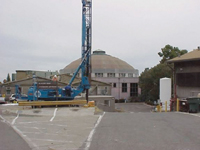 A site next to Building 7 is being excavated to clear underground
utilities for construction of injection wells.
A site next to Building 7 is being excavated to clear underground
utilities for construction of injection wells.
An important milestone toward meeting the September 2006 deadline was recently achieved when the Department of Toxic Substan-ces Control accepted Berkeley Lab’s Draft Corrective Measures Study as technically complete. The public can comment on these proposed remedies until June 8. The study was also the subject of a May 26 public hearing held at the North Berkeley Senior Center.
The study outlines ways in which Berkeley Lab will clean up the remaining sites, which include soil and groundwater contaminated with solvents. These 13 sites may pose a potential threat to people or to the potential future use of the groundwater for drinking purposes. Specifically, two of the areas involve soil contamination. The proposed cleanup strategy for these areas involves digging up the contaminated soil and shipping it for offsite disposal in permitted facilities.
Eleven of the areas involve groundwater contamination. After a series of extensive tests, Berkeley Lab scientists determined that the level of contamination at four of these areas is very small and does not pose a significant risk. Further-more, the affected areas do not constitute a potential source of drinking water. The proposed remedies for the remaining seven areas involve a mixture of flushing contaminants from the soil, collecting and cleaning the contaminated groundwater with activated carbon, and introducing additives into the groundwater to speed up the natural breakdown of solvents.
These groundwater sites are essentially small plumes of industrial solvents, many of which are shrinking, and none of which are threatening offsite areas. Berkeley Lab scientists regularly sample Chicken Creek and the North Fork of Strawberry Creek, and have determined that no contaminants are escaping the Lab.
“When Berkeley Lab’s Environ-mental Restoration Program is completed, the result will be a restored environment and an example of effective policy implementation,” says Javandel. “It is a success story for the community, the University of California (which owns the land), the Department of Energy, and Berkeley Lab.”
Outstanding Employees Rewarded with OPAs
Twenty-three Lab employees, both individuals and teams, were honored last week with Outstanding Performance Awards, or OPAs. The awards recognize significant achievements above and beyond regular job expectations.
This quarter’s award winners are:
Individuals: Catherine A Cooper, Mehlika Inanici, David Paul, Lori Tamura, and Weishi Wan
Teams: Susan J. Lauer and Gao Liu of the Bldg 70 Space Reorganization and Renovation, EETD; Kesheng Wu, Ekow J. Otoo and Arie Shoshani of the Fastbit Index Devel-opment, CR; Ernest Szeto, Frank R. Korzeniewski and Krishnaveni Palaniappan of IMG Development, CR; Ashok J. Gadgil, Lara A. Gundel, Yanbo Pang, Christina Galitsky and Duo Wang of Team Arsenic, EETD; and Cameron GR Geddes, Wim P. Leemans, Csaba Toth, Eric H. Esarey, and Carl B. Schroeder of the Dream Team, AFRD.
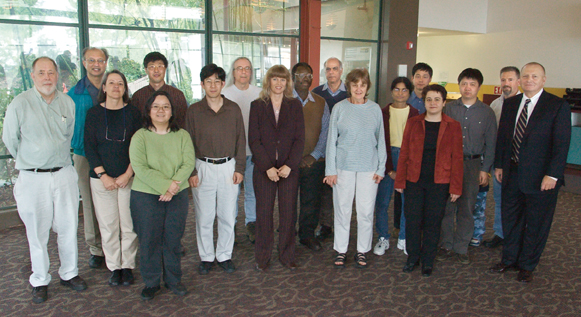 Most OPA recipients attended a May 19 reception hosted by Deputy Director
Graham Fleming and Associate Lab Director David McGraw. Pictured here
are (left to right) Graham Fleming, Ashok Gadgil, Susan Lauer, Duo
Wang, Lori Tamura, Gao Liu, Frank Korzeniewski, Catherine Cooper,
Ekow J. Otoo, Arie Shoshani, Lara Gundel, Krishnaveni Palaniappan,
Kesheng Wu, Mehlika Inanici, Yanbo Pang, David Paul, and David McGraw.
Most OPA recipients attended a May 19 reception hosted by Deputy Director
Graham Fleming and Associate Lab Director David McGraw. Pictured here
are (left to right) Graham Fleming, Ashok Gadgil, Susan Lauer, Duo
Wang, Lori Tamura, Gao Liu, Frank Korzeniewski, Catherine Cooper,
Ekow J. Otoo, Arie Shoshani, Lara Gundel, Krishnaveni Palaniappan,
Kesheng Wu, Mehlika Inanici, Yanbo Pang, David Paul, and David McGraw.
Berkeley Lab View
Published twice a month by the Communications Department for the employees and retirees of Berkeley Lab.
Reid Edwards, Public Affairs Department head
Ron Kolb, Communications Department head
EDITOR
Monica Friedlander, 495-2248, msfriedlander@lbl.gov
STAFF WRITERS
Lyn Hunter, 486-4698
Dan Krotz, 486-4019
Paul Preuss, 486-6249
Lynn Yarris, 486-5375
CONTRIBUTING WRITERS
Jon Bashor, 486-5849
Allan Chen, 486-4210
David Gilbert, (925) 296-5643
FLEA MARKET
486-5771, fleamarket@lbl.gov
Design
Caitlin Youngquist, 486-4020
Creative Services Office
Berkeley Lab
Communications Department
MS 65, One Cyclotron Road, Berkeley CA 94720
(510) 486-5771
Fax: (510) 486-6641
Berkeley Lab is managed by the University of California for the
U.S. Department of Energy.
Online Version
The full text and photographs of each edition of The View, as well
as the Currents archive going back to 1994, are published online on
the Berkeley Lab website under “Publications” in the A-Z
Index. The site allows users to do searches of past articles.
Flea Market
- AUTOS & SUPPLIES
- ‘95 HONDA CIVIC LX, 4 dr, blk, 1.7 L I-4 115 HP, 5 sp man, am/fm/ cass/10-disc CD, 102K mi, pwr locks/win/mirr, cruise, exc cond/mi, airbags, abs, anti-theft/remote, $5,600/bo, Rish, X6768, 710-6552
- ‘95 FORD TAURUS GL SEDAN 4 dr, V6 3.0 L, auto, front whl dr, dark green, 134K mi, air, all pwr, tilt whl, am/fm/cass, premium sound, dual front airbags, ABS, $1,800, Thorsten, X6014
- ‘88 ACURA INTEGRA, 4 sp, 106K mi, Antoinette, X5246, 658-8513
- ‘84 BMW 633csi, CD/radio, elec win, auto, $2,600 champ color, sunrf, blk leather int, new tires/rims, runs/looks good, Regina, 486-4312
- ‘00 BMW ci, auto, premium & cold weather pkg, heated seats, wood grain trim, exc cond, 45K mi, $20,295, Kathleen, (925) 944-5369
- CAR MANUAL, Chiltons import 78-85, $5, Ken, X7739
- HOUSING
- BERKELEY, Cedar/MLK, fully furn 2 bdrm + study/1 bth house, spacious, jacuzzi, garden, nr campus/lab shuttle/shops/BART, http://www. bullybear.org/lp/pic.html, avail 9/1, $1,900/mo + util + dep, no smok/pets, 1-yr lease, Lan-Ping, lpysjw@hotmail.com, 665-3166
- BERKELEY, Elmwood Dist, garden bdrm w/ priv ent in quiet resid area, back of a lge house, avail beg of June, walking dist to campus, Rockridge/BART, no smok/pets, $600/mo + util, water/garbage pd by owner, Barbara, 654-5069
- BERKELEY, 1 bdrm cottage w/ small study, avail this summer, date neg, completely renovated, new kitchen & bthrm, repainted inside & out, completely furn, by summer, $2,000/mo, pets & children welcome, Louise, (609) 923-6909
- BERKELEY HILLS, small inlaw studio w/ sep entry, furn, quiet, nr bus to UCB, no smok, $175/wk incl util, avail thru mid-July, Steve, 649-9504
- BERKELEY HILLS, fully furn 2-rm studio inlaw apt, avail for sublet 6/2 – 8/20, dates flex, sunny, spacious, quiet location, full kitchen & bth, w/d, priv yard, wireless internet, cable TV, parking, nr LBNL, 65 bus line, $700/mo, possible rent reduction for cat care, Arielle, 666-1279
- BERKELEY HILLS, by wk/mo, quiet furn suite, 1 bdrm/1bth + liv rm/kitchenette, quiet, eleg & spacious, bay views, DSL, cable, nr UCB, Pierre, 387-4015, pchew@ pacbell.net
- CENTRAL BERKELEY, small house, 1 bdrm, new kitchen, yard, some util incl, $1,150/mo, Jin.Young@ juno.com, 845-5959
- EL CERRITO HILLS, furn bdrm avail for summer or long term in 5-bdrm home, canyon & hill views, quiet, decks, fp, $750 single occup, incl all util, maid service, prepaid cable TV, priv phone line, share kitchen/bths, nr downtown Berkeley, street parking, 4 friendly tenants, lge house w/ sep wings, trees, hiking trails, kstarkwe@library.berkeley.edu, Marsha, 220-5988
- KENSINGTON HILLS, 1 bdrm apt in house, beautiful neighborhood nr Arlington/shops, view, lge patio, covered porch, lge kitchen, breakfast nook, shared yard, & offstr parking, disposal, double oven, hardwd flrs, built-in cabinets, lease until end of July 2006, $1,095/mo, Donald, 527-5675
- NORTH BERKELEY HILLS, bay view, 3 bdrm house, walking dist to the lab, DSL & wireless internet, avail July – Oct to visiting scientist/ professor, house sitting neg, Voin, 486-8171, vgo@pacbell.net
- ORINDA BERKELEY HILLS, 1 bdrm apt, garden, nr Lab, 1 park space, lge deck & brick patio, woodsy view, quiet area, share util + high sp internet ~ $100/mo extra, full kitchen, w/d connections, 1-year lease, $1,200 sec dep, avail June 1, mtdo42@sbcglobal.net, Jim, (925) 831-9958
- OAKLAND, Glenview Dist, fully furn, 3 bdrm/2 bth condo, 3rd bdrm used as family rm/office, 4-unit bldg, fp, deck, gardens, granite kitchen counters, skylights, bright & sunny, priv garage, store rm, lots of closets, nr Glenview Village/pub trans, 1-year lease, $2,300/mo, avail July 1, 336-0066, rosemary@maxwelllynch.com.
- MISC ITEMS FOR SALE
- PENN 714Z SPINNING REEL, $25; leather brief case, $25; women’s Ecco blk walking shoes, sz 41, $60, worn once, Gloria, 524-0937
- SF OPERA TICKETS, Pearl Fishers, Sat, 6/18, 8 pm, 2nd row balc pair, $124/pair, Paul, X5508, 526-3519
- VACATION
- KIHEI, MAUI, 1 bdrm condo, across street from best beach on Maui, fully equipped, ocean & garden view from lanai,
- 4-night min, $90/night, $525/wk, Faye/John, X6787, X7505, 724-2982, 524-8734 eves
- NORTH LAKE TAHOE house, Kings Beach,
- 3 bdrm/2 bth, sleeps 6, full, kitchen, liv rm, dining area w/ fp, quiet cul-de-sac, great neighborhood, minutes from the beach, no smok/pets, $150/ night, 2 nights min + $95 cleaning fee or $725/week, Linda, 207-1255
- TIME SHARE, Red Wolf Lodge at Squaw Valley Annual, 1 wk usage during the winter season, lodge is right next to Squaw Valley & next to new Squaw Village, $11,999 neg, Bill, X4140
Flea Market Policy
Ads are accepted only from Berkeley Lab employees, retirees, and onsite DOE personnel. Only items of your own personal property may be offered for sale.
Submissions must include name, affiliation, extension, and home phone. Ads must be submitted in writing
(e-mail: fleamarket@lbl.gov, fax: X6641), or mailed/ delivered to Bldg. 65. Email address are included only in housing ads.
Ads run one issue only unless resubmitted, and are repeated only as space permits. The submission deadline for the June 10 issue is Thursday, June 2.